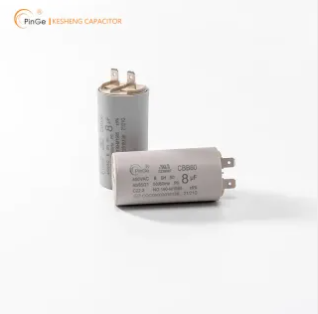A motor start capacitor is an electrical component that is used to provide a temporary increase in the starting torque of a single-phase electric motor. When the motor is started, the capacitor is connected to the start winding of the motor, which causes an increase in the current and starting torque of the motor. Motor start capacitor is designed to be active only for a short period, typically a few seconds, before it is disconnected from the motor circuit. They are only intermittent duty and will fail catastrophically if energized too long. Run capacitors are used for continuous voltage and current control to a motor's windings and are therefore continuous duty. They are generally of a much lower capacitance value.

Start vs. Run Capacitors
Motor start capacitor is designed to be active only for a short period, typically a few seconds, before it is disconnected from the motor circuit. They are only intermittent duty and will fail catastrophically if energized too long. Run capacitors are used for continuous voltage and current control to a motor's windings and are therefore continuous duty. They are generally of a much lower capacitance value.
Are the start and run capacitors interchangeable?
Start and run capacitors are not interchangeable. While both types of capacitors are used in single-phase electric motors, they serve different functions. Start capacitors provide a temporary increase in starting torque, and are only active for a short period, typically a few seconds, before they are disconnected from the motor circuit. Run capacitors, on the other hand, have a smaller capacitance rating and are designed for continuous duty operation because they remain in the circuit all the time. Using a start capacitor as a replacement for a run capacitor can cause overheating and premature failure, and can even damage the motor. It is important to always use the correct type of capacitor for your motor.
Troubleshooting
How do I know if my start capacitor is bad?
There are a few signs that may indicate a bad start capacitor in a single-phase electric motor:
The motor won't start: If the motor fails to start, the start capacitor is one of the first components you should check. If it is faulty, it will prevent the motor from starting.
Motor is slow to start: Your starting capacitor may be losing its capacitance rating due to wear and age, or you may have other non-capacitor related problems with other motor components.
Intermittent starting: If the motor starts intermittently, or requires multiple attempts to start, it could indicate a problem with the start capacitor.
Loud humming sound: If you hear a loud humming sound coming from the motor when you attempt to start it, it could indicate a faulty start capacitor.
Swollen or leaking capacitor: If the start capacitor appears swollen or has leaked fluid, it is likely that it has failed.
Burnt smell: If you detect a burnt smell coming from the motor, it could be due to a failed capacitor.
If you suspect that your start capacitor is faulty, it's important to have it checked and replaced by a qualified electrician or technician to ensure the safe and efficient operation of your motor.
Specifications
We supply motor start capacitors use a rating of 1-100 uf capacitance and voltages of 250~500 VAC. They are also usually always 50 and 60 Hz rated. Case designs are typically round. Terminations are usually ¼" push on terminals with two terminals per connection post.
Voltage
Select a capacitor with a voltage rating at or above the original capacitor. If you're using a 370 volt capacitor, a 370 or 440 volt one will work. The 440 volt unit will actually last longer. A capacitor will have a marked voltage indicating the accpetable peak voltage, not operational voltage.
Capacitance
Select a capacitor with a capacitance value (given in MFD, uf or microfarad) that is equal to the original capacitor. Do not deviate from the original value, as it sets the operational characteristics of the motor.
Frequency (Hz)
Select a capacitor with the Hz rating of the original. Nearly all replacement capacitors will be labeled 50/60.
Connection terminal style
Nearly every capacitor will use a ¼" flag style push-on connector. The next question is, "How many terminals per terminal post are needed for the application motor?" Most start capacitors have two terminals per post, and most run capacitors will have either 3 or 4 terminals per post. Verify that your selected capacitor has at least the number of connection terminals per connection post as the original motor capacitor.
Case shape
Nearly all start capacitors have a round case. Round run capacitors are by far the most common, but many motors still use oval designs. Electrically speaking, there is no difference. Fit is the only question here. If space in the mounting box is not limited, the case style does not matter.
Case size
Just like case shape, overall size makes no difference electrically. Select a capacitor that will fit within the space provided.
The following are our specific products, you can click to browse or contact our engineers to choose motor start capacitor for you.